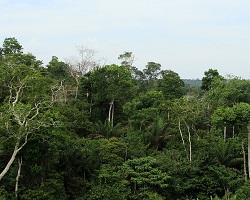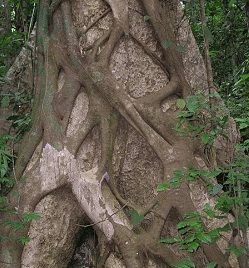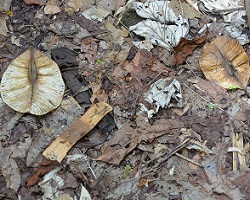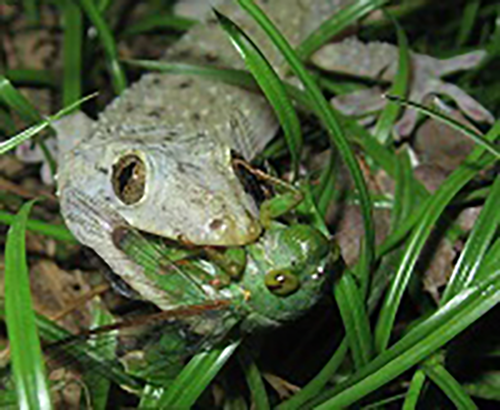show/hide words to know
Adaptation: a structure or behavior that helps an organism survive and reproduce.
Epiphyte: a plant that grows on another plant or object, without stealing its water or nutrients.
Sapling: a young tree.
Vine: a plant with a long stem that can reach far and climb high, as long as it has a structure on which it can grow.
Animals All Around
Now we know what makes us call certain forests rainforests, but how can one biome hold so many animals? Part of the secret has to do with all the different layers of a rainforest.
That’s right, a rainforest isn’t all made up of the same stuff. If we look at a rainforest from top to bottom, we can see how in just one biome, there are many different habitats for animals and plants to use.
From the Top

The tops of trees can form a dense layer of branches and leaves, called the canopy. Image by Ben Sutherland.
Many of the tall trees in a rainforest shoot straight up and only have branches and leaves near the very top.
With tons of trees packed in like this, the tree tops create a blanket of leaves hundreds of feet above the forest floor. This leafy layer of the forest is called the canopy, and it blocks out most of the sunlight, shading the layers underneath.
As we look at the trunks of the trees, we find vines that start in the ground and wrap around the trees. Sometimes these vines reach from the base of the tree all the way up to the sunlight in the canopy.

This large vine, called a strangler fig, is growing in a criss-cross pattern around a tree. Image by L. Shyamal.
However, a special vine called a strangler fig starts from the canopy and reaches down to the ground. Other plants called epiphytes can also grow without ever touching the ground—they attach their roots to tree branches instead of soil.
If we keep going down to the shaded lower levels of the forest, called the understory, we find fierce competition among the plants that are trying to grow. These plants depend on sunlight to grow, but with so much shade from the canopy, areas with sunlight can be hard to find.
Sometimes, when a large tree dies and falls over, a light gap is created and sunlight hits the forest floor. In the spots of light on the forest floor, young trees called saplings that may have been struggling to survive in the shade for 20 years or more will use the opportunity to grow quickly and try to reach more sunlight in the canopy.
To the Bottom
When we reach all the way down to the forest floor, hundreds of feet below the canopy, we find a thin habitat made of leftovers from other forest layers.

The forest floor has a layer of dead leaves and other plant and animal matter. Image by Charles Kazilek.
Leaf litter covers this bottom layer of soil. Any dead plant or animal material that falls to the floor becomes food for fungi or bacteria. In a day or two, these microorganisms can break down a leaf or a banana peel into small bits and pieces we call nutrients.
With so many plants on the forest floor that need these nutrients to grow, the nutrients have no chance to sink down deep into the soil. This means that most plants must have roots that are shallow to grab the nutrients as they are formed. This is just one example of many special tricks, called adaptations, which plants use to survive.
Images via Wikimedia commons.
Additional image by David Gärtner.
View Citation
Bibliographic details:
- Article: Anatomy of the Rainforest
- Author(s): Karla Moeller
- Publisher: Arizona State University School of Life Sciences Ask A Biologist
- Site name: ASU - Ask A Biologist
- Date published: July 24, 2013
- Date accessed: April 17, 2024
- Link: https://askabiologist.asu.edu/anatomy-rainforest
APA Style
Karla Moeller. (2013, July 24). Anatomy of the Rainforest. ASU - Ask A Biologist. Retrieved April 17, 2024 from https://askabiologist.asu.edu/anatomy-rainforest
Chicago Manual of Style
Karla Moeller. "Anatomy of the Rainforest". ASU - Ask A Biologist. 24 July, 2013. https://askabiologist.asu.edu/anatomy-rainforest
Karla Moeller. "Anatomy of the Rainforest". ASU - Ask A Biologist. 24 Jul 2013. ASU - Ask A Biologist, Web. 17 Apr 2024. https://askabiologist.asu.edu/anatomy-rainforest
MLA 2017 Style

Rainforests have all kinds of habitats for animals, from those in the tree tops to those on the forest floor.
Be Part of
Ask A Biologist
By volunteering, or simply sending us feedback on the site. Scientists, teachers, writers, illustrators, and translators are all important to the program. If you are interested in helping with the website we have a Volunteers page to get the process started.









